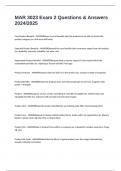MAR 3023 Exam 2 Questions & Answers
2024/2025
Core Product Benefits - ANSWERSbasic level of benefits that the product has to offer to fit into the
product category (ex. drill must drill holes)
Expected Product Benefits - ANSWERSbeyond the core benefits that consumers expect from the product
(ex. durability, warranty, reliability, fair price, etc)
Augmented Product Benefits - ANSWERSbeyond what customer expects & thus beyond what the
competition provides (ex. replacing a 30 year old drill, Ford app)
Product Features - ANSWERSaspects that are built in to the product (ex. racquet is made of tungsten)
Product Benefits - ANSWERSwhat the product does and what people get out of it (ex. tungsten adds
power + strength)
Product - ANSWERSa good, service, or idea consisting of a bundle of tangible (ex. drilled holes) and
intangible benefits (ex. improved self-concept & brand-name image)
Product Item - ANSWERSspecific product identified by an ordering code (SKU: Stock-keeping Unit)
Product Line - ANSWERSgroup of closely related product items. Exists within an organization (ex. Black &
Decker's power tools, Big Mac/Mac Jr./Grand Mac)
Product Mix - ANSWERSset of product lines sold by a company (ex. Campbell's includes soup lines, Prego,
V8, etc)
Product Life Cycle - ANSWERSdescribes the life of a typical product over four stages (Introduction,
Growth, Maturity, & Decline)
,Introduction Stage of the PLC - ANSWERSslow growth as market comes to accept the product. Few
suppliers. Focus on promotion + building awareness.
Primary Demand - ANSWERSdesire for product class rather than specific brand, Stimulated in the
Introduction stage of the PLC
Skimming Strategy - ANSWERSfirm sets a high initial price to help recover development costs. Works
because customers are more price-insensitive up front
Penetration Pricing Strategy - ANSWERSfirm sets a low initial price to build unit volume and gain market
share
Growth Stage of the PLC - ANSWERSrapid growth as competitors enter the market. Focus on widespread
distribution to establish brand before competitors can.
Selective Demand - ANSWERSpreference for a specific brand. Advertising shifts to this during the growth
stage of the PLC.
Maturity Stage of the PLC - ANSWERSslowing of growth. Competitive shakeout (some competitors leave
the market + invest money elsewhere). Focus on making product variations to battle competition & gain
+ retain as much of the market as possible.
Decline Stage of the PLC - ANSWERSsharp decrease in sales. Can lead to product deletion or harvesting.
Harvesting - ANSWERScompany retains the product but reduces marketing costs. Strategy used during
decline stage rather than product deletion.
Fad Product - ANSWERSshort-lived product whose PLC quickly peaks and then rapidly decreases. (ex.
Beanie Babies, Tamagotchis, etc)
Product Class Life Cycle - ANSWERSentire product category or industry (ex. automobile tires)
,Product Form Life Cycle - ANSWERSproduct forms within the class. Usually driven by technology and
consumer tastes (ex. steel-belted radial tires vs. non-inflatable tires vs. low-profile tires, condensed
soups vs. ready-to-eat soups)
Brand Product Life Cycle - ANSWERSspecific brands within a product form. Brand Managers are in control
of this level of the PLC (ex. Goodyear tires)
Four Ways to Extend the PLC - ANSWERSMarket Penetration, Market Development, Product
Modification, Product Repositioning
Market Penetration - ANSWERSextending PLC by selling more of the product to the same basic set of
customers. Lower prices, offer coupons, etc. Attempt to achieve a greater share of wallet (% of
customers' expenditures that the firm accounts for)
Market Development - ANSWERSextending PLC by looking for new markets. (ex. Exporting, targeting new
user group, Apple targeting business for iPad sales)
Product Modification - ANSWERSextending the PLC by altering a product's characteristics (quality,
performance, appearance) to serve the changing needs of the marketplace. (ex. Tide's changes, Lay's
flavor competition, Barbie's jobs)
Product Repositioning - ANSWERSextending the PLC by changing the position that a product occupies in
the mind of a consumer. (ex. Cadillac changed from old person car to young person car, A1 Steak Sauce
changed to A1 Sauce)
Can result from reacting to competitor's position, wanting to reach a new market, catching a rising trend,
changing the value offered (trading up: adding value, trading down: reducing # of features, quality, or
price)
Brand Development Index (BDI) - ANSWERSused to determine how well a firm's brand is performing in
each geographic territory in which it sells.
BDI= ($ brand sales per capita in Territory J)/($ brand sales per capital nationally) * 100
, Category Development Index (CDI) - ANSWERSmeasures how an entire product category is performing in
the market.
CDI= ($ category sales per capita in territory J)/($ category sales per capita nationally) * 100
Brand Name - ANSWERSverbal label that is attached to a product (ex. Cadillac, Febreeze, Best Western)
Brand Mark - ANSWERSnonverbal mark for the brand (ex. McD's golden arches, Nike Swoosh, Gator
Head)
Trade Character - ANSWERSpersonified representation on the brand (ex. Planter's Mr. Peanut, Pillsbury
Doughboy)
Trademark - ANSWERSbrand name, brand mark, or trade character that is legally protected
Logo - ANSWERScan consist of brand name, brand mark, or both
Family/multiproduct Branding - ANSWERSfirm puts same basic brand name on all the products it sells
(ex. Nike shoes, hats, pants) Takes advantage of strong brand name
Multiple Branding/Mixed Branding - ANSWERScompany attaches different brand names to the various
products it sells. Costlier & more research-intensive (ex. Procter & Gamble Tide, Cheer, etc).
Differentiates so that each brand stands for something different (ex. high-end, low-end)
Co-Branding - ANSWERSwhen two companies or brands cooperate and put both brand names on a
product (ex. Kraft's cheese box looking like crayola crayons, NCAA Duct Tape)
National Brands - ANSWERSbrands we typically talk about in the context of consumer goods. Designed to
attract consumers to the brand and develop brand loyalty. Tend to have highest perceived quality + price.
(ex. Nike, Ford, Kellogg's)
Private Label Brands - ANSWERSbrands associated with a particular retailer. Usually charge 5-15%
cheaper than national brands. Build store loyalty rather than brand loyalty (ex. Publix, Walmart's Great
Value)




